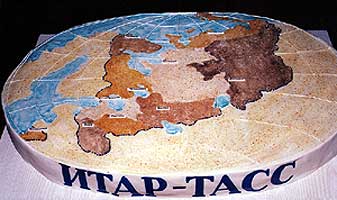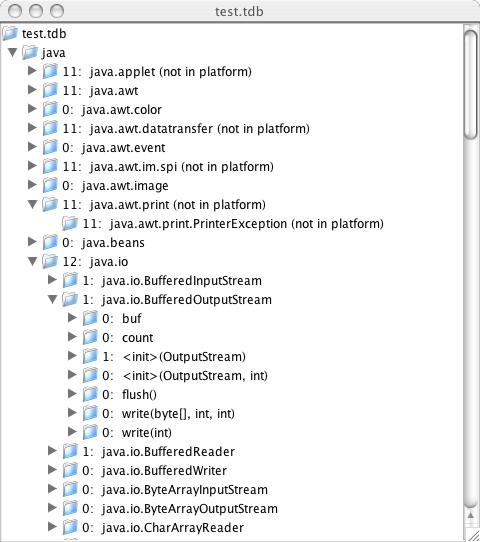TASS version 0.4.1 - Test Application Signature Safety
The source code for TASS is available on java.net, at
http://java.net/projects/tass/.

TASS is a program to analyze the class files of an application. In
other words, it delivers you news about your application. It can
check the static references in application class files, and compare
them to
a target platfrom.
It reads all of the classes of an application,
and inspects each class file. All references outside of the class
file are inspected, if the reference is to a platform package.
References to API elements in a platform package are flagged
as errors if the API elements are not present in the platform
definition. External references to non-platform packages are
not checked.
Additionally, TASS allows you to collect information about the API
elements used by several applications into a small database file. This
database file can be analyzed and reported on in various ways.
What is TASS for?
TASS is intended to be used in situations where you receive a
compiled application or library, and you want to check to
see if it unintentionally uses API elements that are not guaranteed
to be present in a target device, like an MHP or BD-J terminal. In
practice, this is sometimes a problem, for example if code is
developed by hand using J2SE on a PC, or otherwise taken from
a different environment. Usually these errors are easy to
correct, once found, but they won't necessarily be noticed on
all terminal implementations. This is because a terminal implementation
may include a superset of the minimum API elements required, under
certain limited conditions. TASS can also help you understand what
platform features are and aren't used by a set of applications.
TASS is not a tool intended to do more in-depth static
checking of Java code than is already done by javac. Javac does a
good job of static checking already; if you have the source code
to an application,
javac -bootclasspath <platform classes> <app source>
will give you more information, and better error messages. TASS
is not lint: lint made up for the limitations of static checking
in pre-ANSI C compilers. Such a tool is not necessary in java, where
javac already does a very good job of static validation.
What does TASS require to work?
This program requires a set of .class files representing the
platform. It is not provided in this distribution. "Stub" class
files, representing the external API but with no meaningful
method implementations may be available for this purpose. If not,
one can check against a real platform implementation, but sometimes
real platform implementations contain API elements that are not
guaranteed to be present. If this is a risk, then finding a set
of platform stub classes is recommended.
In addition to platform stubs, this program needs a list of
packages that are considered to define the platform. An example,
derived from publicly-available informative documents describing
the BD-J platform, is available as
lib/packages.txt.
This product includes software developed by the
Apache Software Foundation
(http://www.apache.org/). Specifically,
this program relies on the BCEL library version 5.1, which comes from
the Jakarta project. It is available at
http://jakarta.apache.org/bcel/, and a copy is included with this distribution. The BCEL
license is available in
bcel-5.1/LICENSE.txt.
I don't recommend using a later version of BCEL without
careful consideration, because it's
possible that the behavior of later versions may not be
backwards compatible. For example, the syntax of some of the
string representations might change.
Sample Run
A sample run is shown below. In it, TASS is run against a mock
application that intentionally contains many bad references.
./run.sh
Error in bad$1: Class file version number 48.0 is greater than maximum 47.0
Error in bad$1: Platform class java.awt.datatransfer.ClipboardOwner not found.
Error in bad$1: Platform class java.awt.datatransfer.Clipboard not found.
Error in bad$1: Platform class java.awt.datatransfer.Transferable not found.
Error in bad$2: Class file version number 48.0 is greater than maximum 47.0
Error in bad$2: Platform class java.awt.datatransfer.DataFlavor not found.
Error in bad: Class file version number 48.0 is greater than maximum 47.0
Error in bad: Platform class java.applet.Applet not found.
Error in bad: Platform class java.applet.AppletContext not found.
Error in bad: Platform class java.awt.im.spi.InputMethod not found.
Error in bad: Platform class java.awt.print.PrinterException not found.
Error in bad: Platform class java.nio.channels.ByteChannel not found.
Error in bad: Platform method java.awt.Graphics2D.rotate(double) not found.
Error in bad: Platform method java.awt.Graphics2D.rotate(double, double, double) not found.
Error in bad: Platform method java.awt.Graphics2D.setPaint(java.awt.Paint) not found.
Error in bad: Platform field java.awt.Color.BLACK not found.
Application had 16 error(s). Exiting with exit code 1
The entry point for this test program is the class
Test.
TASS contains a reporting module that allows one to analyze the
platform API signatures referenced by an application. This can be
useful, for example, to survey a number of applications and determine
what platform features are used.
It is useful
to consider the limitations of this simple form of
static analysis. One must consider
the implications of a static reference to a platform API
signature. Take, for example, this code snippet:
java.util.Set hs = new java.util.HashSet();
hs.contains(null);
In this code, there is a reference to the constructor
of HashSet, and there is a reference to the method
Set.contains(Object). There is no static refence to
HashSet.contains(Object), even though this method
will clearly be called. Unless one employs data-flow analysis,
dynamic method-call tracking or other more advanced analysis
techniques, the best
that one can conclude from the simple static analysis done by TASS
is that there is a reference to an inherited declaration of
HashSet.contains(Object). To take another example,
consider:
public String callObjectToString(Object foo) {
return foo.toString();
}
A fair number of classes override toString(). With this
method present, simple static analysis is forced to conclude that
all such classes might have their to toString() method
invoked, even though most of them probably don't.
Finally, one must consider reflection. An application using
the java.lang.reflect.* classes could, in principle,
call any platform API. Such calls are not detectable using simple
static analysis. However, such fully reflective access should be
a very rare exception in typical applications.
For reporting, application references are captured in a database
file, given the extension ".tdb". Multiple applications can be
captured in a database, and database files can be merged. There's
also a GUI viewer of a database file. These
functions can be run from their own "main" entry points. In each case,
a sample shell script ot run the application is provided. Details on
these other entry points are available
in the javadocs of the class containing the static main method. See:
A sample of the reports is given below:
************************************************
REPORT OF PLATFORM PACKAGE USAGE
************************************************
11: (java.applet - not in platform)
11: java.awt
0: java.awt.color
<...>
**********************************************
REPORT OF PLATFORM CLASS USAGE
**********************************************
Package java.applet
11: (java.applet.Applet - not in platform)
11: (java.applet.AppletContext - not in platform)
Package java.awt
0: java.awt.ActiveEvent
0: java.awt.Adjustable
0: java.awt.AlphaComposite
0: java.awt.AWTError
0: java.awt.AWTEvent
0: java.awt.AWTEventMulticaster
0: java.awt.AWTException
0: java.awt.AWTPermission
0: java.awt.BorderLayout
11: java.awt.CardLayout
11: java.awt.Color
0: java.awt.Component
0: java.awt.Composite
***********************************************
REPORT OF PLATFORM MEMBER USAGE
***********************************************
<...>
Class java.util.Set
1 (s1): java.util.Set.add(Object)
0 (s0): java.util.Set.addAll(Collection)
0 (s0): java.util.Set.clear()
11 (s11): java.util.Set.contains(Object)
<...>
Class java.util.HashSet
12 : java.util.HashSet.()
0 : java.util.HashSet.(Collection)
0 : java.util.HashSet.(int)
0 : java.util.HashSet.(int, float)
1 (s1): java.util.HashSet.add(Object)
0 (s0): java.util.HashSet.clear()
0 (s0): java.util.HashSet.clone()
1 (s12): java.util.HashSet.contains(Object)
0 (s0): java.util.HashSet.isEmpty()
1 (s1): java.util.HashSet.iterator()
0 (s0): java.util.HashSet.remove(Object)
<...>
A screenshot of the database viewer follows:

Information about this distribution
Javadocs for TASS are available in
javadocs/index.html.
The TASS program's main entry point is the class
TassChecker. Also included is a simple commmand-line main
program to drive TassChecker. It's intended mostly for testing
purposes and as an example, although it could be adapted if a
command-line tool is desired. Otherwise, TassChecker can be used
directly from any Java program.
I built and tested TASS against JDK 1.4, but any subsequent version
should work.
A simple shell script to build and run TASS is included, in "run.sh".
It should work on any Unix system, like OS/X. It runs TASS against
a simple set of files in the directory "test_prog". These classes
intentionally reference API elements that are unlikely to be present
in a 2005-era standards-based specification including JavaTV.
TASS itself is offered under the Sun Public License,
reproduced in
LICENSE.html. Its terms are quite
generous.
TASS is freely available at
http://jovial.com/tass/. It was
also a project under java.net at
https://tass.dev.java.net, which is archived at
https://github.com/zathras/java.net/tree/master/tass. The
java.net project is identical, but gives you the option of signing
up for announcements, such as the publication of a new version. If
you just want a copy of the distribution, it's available from
either place in tass.zip, linked out of this
top-level HTML page. It includes source, binary, and BCEL.
Update History
Before TASS was moved to java.net, it was distributed through a group
called DVB-MUG. For this reason, the version numbers are given as
revision numbers of a document called "mug134". Subsequently, version
numbers started with 0.3.
Version mug134r2 adds checking of the class file version number.
Version mug134r3:
- Fixed bug: platform classes are now checked to make sure they're public,
so attempted access to package-private classes will be flagged.
- Added the new reporting feature.
Version mug134r4:
- Fixed bug: Checks the class file version number for classes inside
a zip archive now.
- Created new reporting and database functions.
- Removed old reporting functions from TassChecker, as they have
been superceded.
Version mug134r5 adds the GUI viewer, TdbViewer.
Version 0.3, 23 May 2006:
- Re-structured project to move it to java.net,
and did some minor cleanup and directory restructuring.
- README.html was moved to www/index.html.
- Added bin/tass shell script to the distribution.
- Improved TdbViewer, giving cumulative counts of references
at package level, top-level package level and for all packages.
- Added "A Final Word."
Version 0.4, 7 June 2006:
- Added to usage message of AddToTassDatabase command, to make clear that
you run the program once per application, and not once per set of
applications.
- Fixed a bug in TassViewer where all packages were reported as not
being in the platform.
Version 0.4.1, 8 June 2006:
- Fixed NullPointerException in merge program, introduced in version 0.4
A Final Word...
I hope this software is found to be useful. If you use TASS, please
consider a donation to your favorite charity.
Bill bill.foote at sun.com

